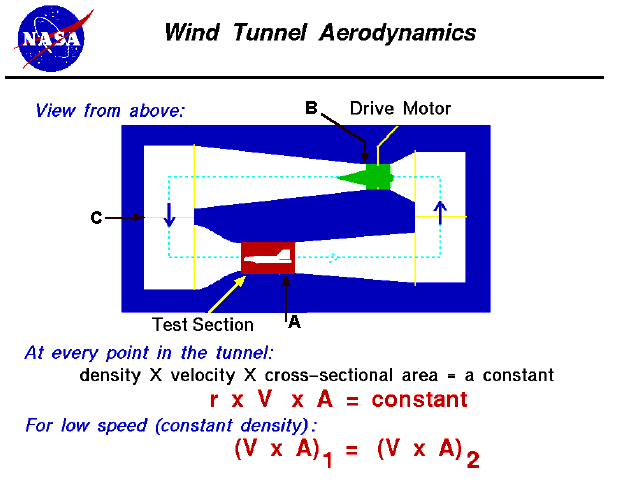|
|
-
Wind
Tunnel Aerodynamics Activity
If so instructed by your teacher, print out a worksheet
page for these problems.
Open the slides called
Bernoulli's Equation (with
text) and Wind Tunnel Aerodynamics
(with text) and read the explanations of the relationships between air
velocity, pressure, and density in a closed system of varying cross section
like a wind tunnel.
Shown below is an
image of a typical wind tunnel with three cross sections: A (test section),
B (Fan Outlet) and C .

The wind tunnel test
section (A), as in some operating wind tunnels, can be resized by moving
the walls, ceiling and/or floor to give a different cross-sectional area.
The other two sections B and C are not adjustable. Give all answers to the
nearest hundredth.
- The measured velocity
in the rectangular test section (A) is 10 m/sec. The initial dimensions
of the test section are 3 m high and 4 m wide.
- What
is the cross-sectional area (A)? ________________
- What is the
constant (V x A)? ________________
- What cross-sectional
area (A) will I need to double the velocity? ________________
- What cross-sectional
area ( A) will I need to decrease the velocity fourfold? ________________
- What would
the velocity be if I changed the dimensions to 6 m high and 4
m wide?_____________________________
- What would
the velocity be if I changed the dimensions to 5 m high and 5
m wide? _____________________________
- Assume that the
wind tunnel test section (A) is triangular. Our initial velocity is
still 10 m/sec.
- What
is the formula for the area of a triangular cross-section? ________________
- The triangular
test section has a base of 5 m and a height of 4 m. What is the
Area (A)? _____________________________
- What is the
constant (V x A)? _____________________________
- What cross-sectional
area (A) will I need to double the velocity? _____________________________
- Give a base
and height measurement which would result in the cross-sectional
area in Problem 2d. _____________________________
- What would
the velocity be if I changed the dimensions to a base of 8 m and
a height of 10 m? _____________________________
- The fan exit section
(B) is circular in shape. The initial velocity is again 10 m/sec.
- What
is the formula for the area of a circular cross section? _____________________________
- The cross-sectional
area of B is 20 sq. m. What is the radius? _____________________________
- What is the
constant (V x A)? _____________________________
- If I rebuilt
this section, what radius would be required to generate a velocity
of 50 m/sec.? _____________________________
- The cross-sectional
areas of Test Section (A), Fan Exit Section (B), and Section C are 20,
60, and 100 m respectively. The velocity at B, the Fan Exit Section,
is 50 m/sec.
- What
is the constant (V x A)? _______________________________________
- What is the
velocity at cross section C? _______________________________________
- What is the
velocity at Test Section A? _______________________________________
|
